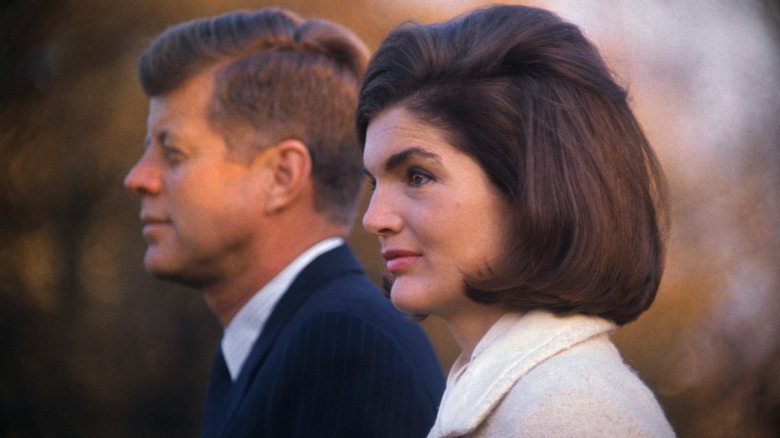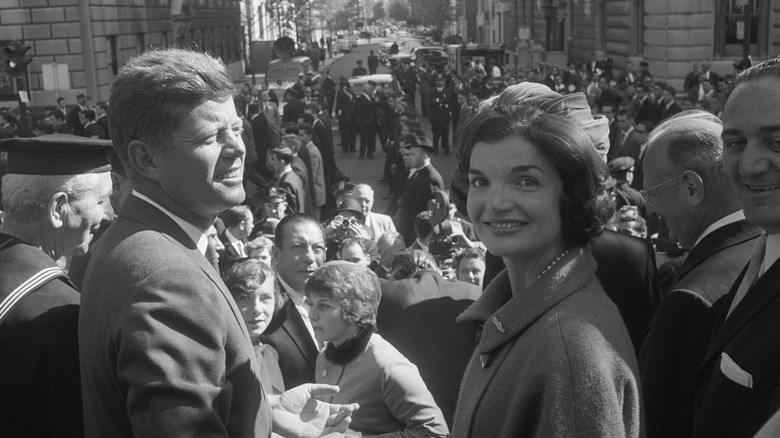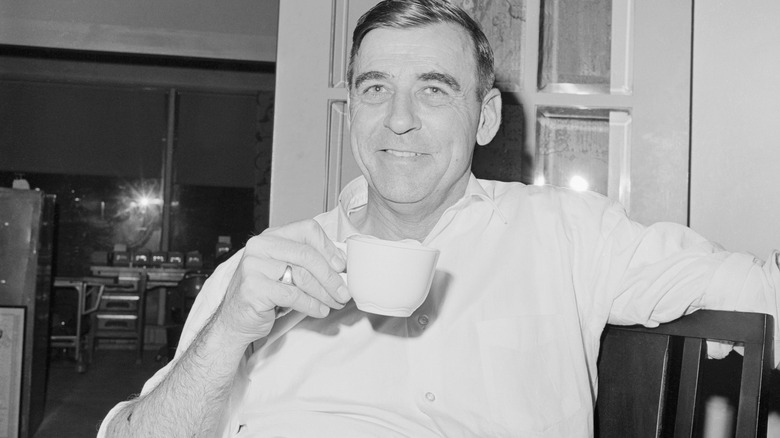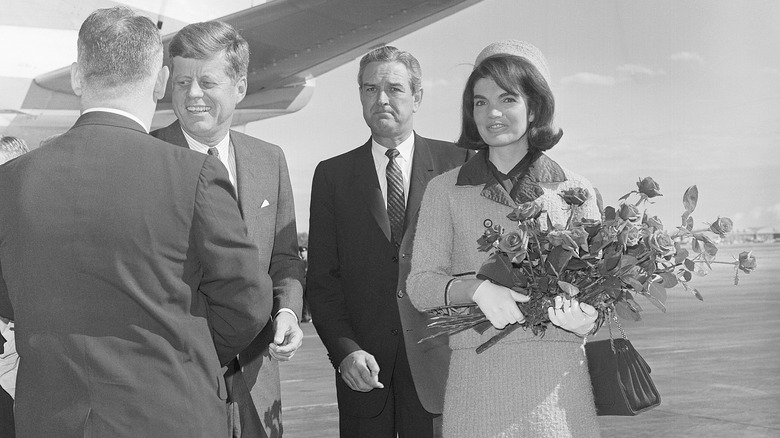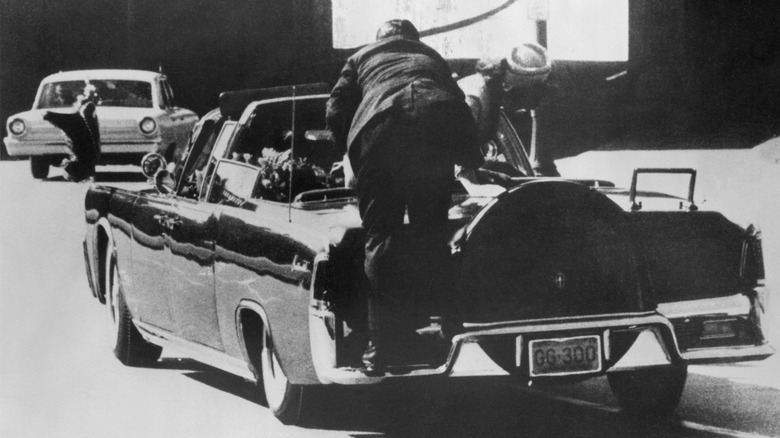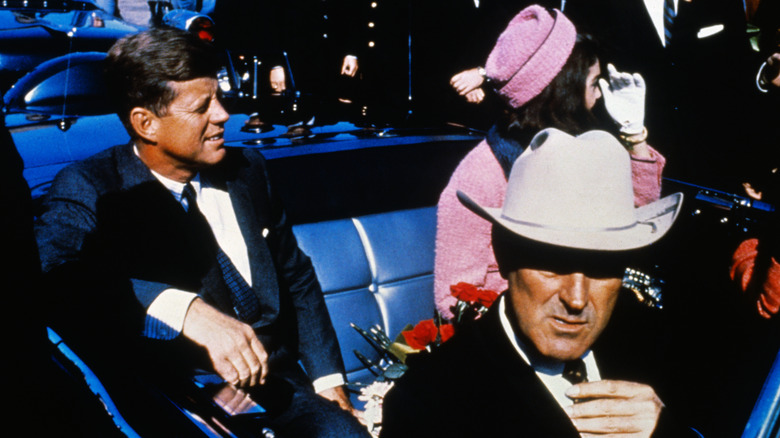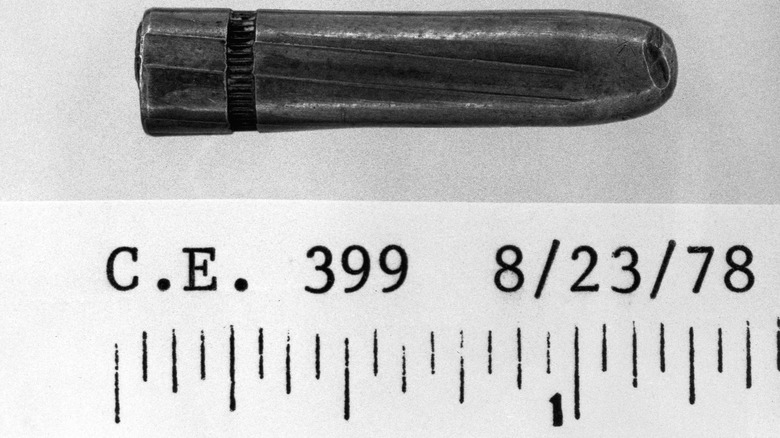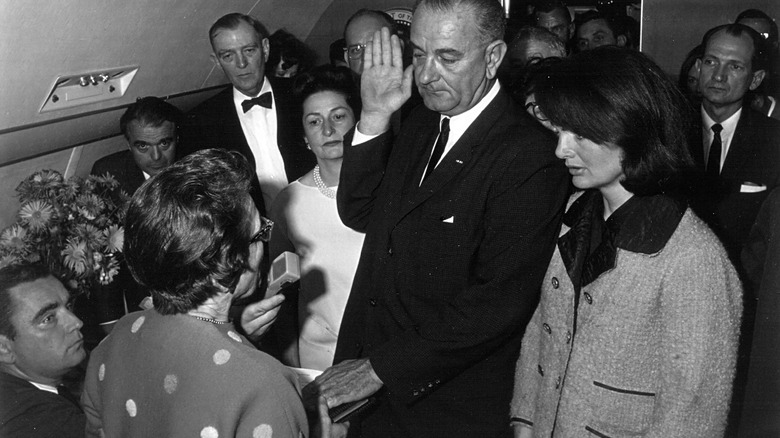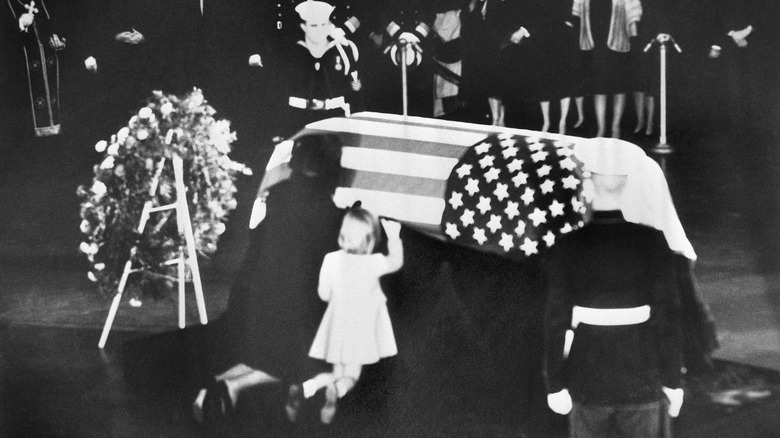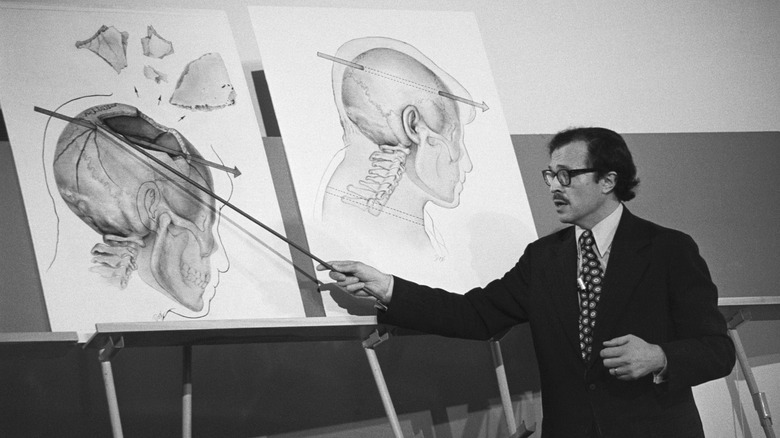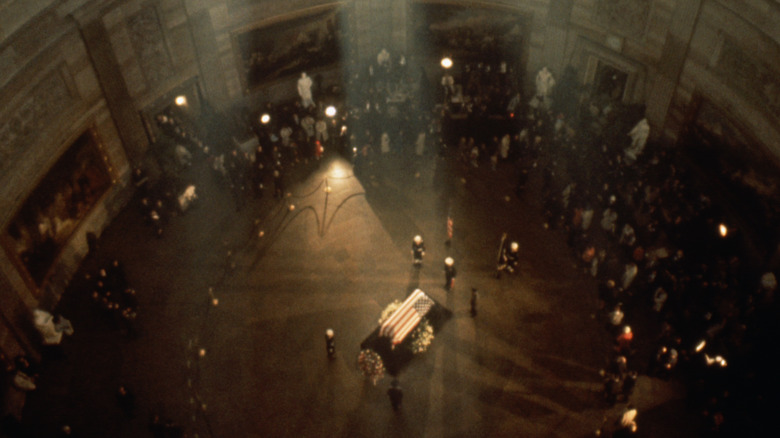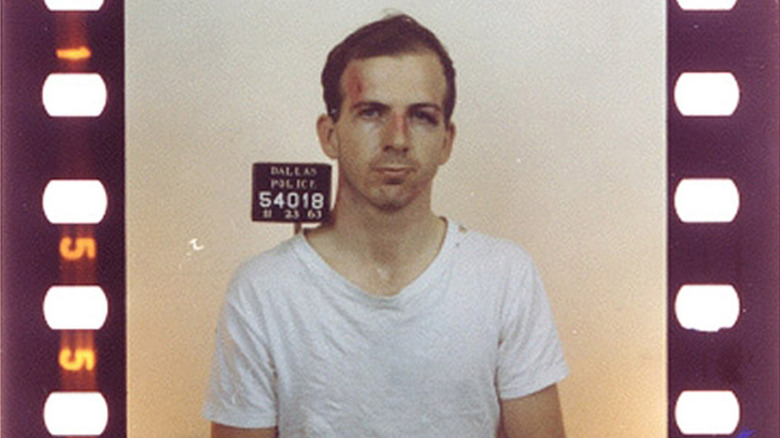The Timeline Of JFK's Assassination Explained
It's one of the most famous moments in American history: The assassination of President John F. Kennedy. It's the moment that every single person of an entire generation — regardless of political alliances — remembered so vividly, with it often being said that everyone knew where they were and what they were doing when they heard the president had been killed.
It was a sunny November day in Dallas, Texas... and although there's a lot that's been told and retold over the decades since the assassination, there's plenty of lesser-known tidbits of fascinating information that have been largely overlooked along the way. The fact that it was sunny was once part of some heavy-duty speculation: Because it had stopped raining earlier in the day, the presidential car had a protective plastic roof removed. Would it have made a difference? No: In spite of later claims, Gary Mack — curator of the Sixth Floor Museum at Dealey Plaza — has said (via The Dallas Morning News) that the missing top wasn't bulletproof.
Here's another strange tidbit: When Lyndon B. Johnson was sworn into office, he needed a car ASAP. The solution? Strip down and clean the car that the Kennedys had been riding in during the assassination, give it a fresh coat of paint, and put it back into service. And it would stay there through Johnson's, Nixon's, and into Carter's terms, when it was finally retired. Strange? It's not the strangest thing that happened around one of the most shocking events in American history.
A 1960 assassination attempt had already failed
The story of the assassination of President John F. Kennedy arguably starts way back in December of 1960. Why? Because that was when the first attempt was made on his life. While it was Lee Harvey Oswald who would later gain notoriety as the official assassin, it was a 73-year-old former postal worker and New Hampshire resident named Richard Paul Pavlick who made the first attempt.
Pavlick was pretty serious, too: He ended up following the Kennedy family to Palm Beach and staked out their vacation home with his car full of explosives. The idea was that he was going to ram Kennedy's car and send them both to meet their makers, but he didn't end up going through with it. When he saw Jackie Kennedy get into the car with Caroline and JFK Jr., he called it off and was ultimately arrested before he could make another attempt. It soon became clear that he had been following the Kennedys for a while: He had sent a series of postcards to his hometown's postmaster general, who became concerned and alerted authorities. Pavlick was found legally insane and was committed to a mental institution, where he remained until 1966.
When Time reported on the attempt, they also quoted Pavlick's explanation as to why he had become so determined to kill the president-elect: "The Kennedy money bought him the White House. I wanted to teach the United States the presidency is not for sale."
Lee Harvey Oswald attempted another assassination months before JFK's
The blame for Kennedy's assassination would be placed squarely on Lee Harvey Oswald, and without getting into the controversy behind that, it's worth mentioning that it apparently wasn't the first time he had decided to further his political agenda by killing someone he thought was standing in the way. Who was that? A U.S. Army general named Edwin Walker (pictured, at his Dallas home). Walker was a pretty controversial figure at the time, known for his extreme, right-wing views, including calling for the assassination of Fidel Castro.
Journalist and author Bill Minutaglio says (via History) that's where Oswald came in. It's presumed that Oswald saw Walker as an immediate threat to his beloved Communist regime, so on April 10, 1963, he set himself up behind a fence near Walker's home and at 9 p.m., found himself with a pretty perfect shot at the general. He fired one shot and inexplicably missed, sending the general running outside after the would-be assassin.
And here's where there's one of those weird things that — in hindsight — can be pointed at as having the potential to have changed history. Even though the Dallas police were convinced that the shot fired at Walker had been a deliberate assassination attempt, they had no suspect. Minutaglio says, "Some people have criticized the investigation of the Walker assassination attempt. They say, if it had been a truly deep and thorough investigation, then Oswald would have been arrested and imprisoned, and JFK would have lived."
Here's why JFK was in Dallas in the first place
If it hadn't been for the assassination, President John F. Kennedy's time in Texas would have been standard stuff. There was a whirlwind tour of five Texas cities scheduled over the course of two days, and according to Jeb Byrne, a member of JFK's General Services Administration, he had been sent ahead to start planning things about 10 days before the president got there. In a piece preserved in the National Archives, he wrote about how the idea behind the trip was to help cement loyalties ahead of an announcement officially confirming his reelection campaign.
Byrne recounted nightmarishly busy days. By the time JFK got to Fort Worth, Byrne recalled thousands of cheering spectators, a rainy, overcast day, and seeing Jacqueline Kennedy wearing that famous pink suit for the first time: She stepped into the kitchen to greet the staff at the hotel where they would be having breakfast. The Kennedys were charming, speeches were given, and then they had some downtime.
Before leaving for Dallas, Byrne says the Kennedys took in an art exhibit, JFK called FDR's former vice president to wish him a happy birthday, and when he read the morning paper, he noticed an ad that had been placed by right-wing extremists and suggested the president was a threat to the nation's security, and at this, Byrne wrote, "Kennedy mused out loud at this point about how easy it would be to assassinate a traveling president." Then, it was off to Dallas.
The moments of the assassination according to Secret Service Agent Clint Hill
Everyone's familiar with the scene: The presidential motorcade rolls down the street in Dallas, gunshots ring out, and chaos descends. So, let's get up close and personal with someone who had a front-row seat: Secret Service agent Clint Hill. He told Radio Diaries (via NPR), "Before Dallas, I was known as just Clint Hill. After that, I've been known as the man who climbed onto the president's car. That six-second period in Dallas, it's not an easy thing to live with."
Hill was officially in charge of protecting not JFK, but Jackie Kennedy: He has said that in the first instant, no one was sure what had happened. He thought of firecrackers first, and it was only when he saw JFK fall that he realized what was happening. Hill had been riding on the car behind the president, and that's when those famous photos were taken. He ran forward, jumped on the trunk, pushed Jackie Kennedy back into the back seat, and shielded them as the car took off.
Hill says that the instant it happened, he knew there was no chance for JFK to survive. He also said that in the weeks before the assassination, JFK and Jackie had reconnected over a shared tragedy: The death of their son, Patrick. He had died at two days old, and Hill says (via The Guardian) that's why Jackie had broken from a long-standing tradition and decided to join her husband on his trip to Dallas.
The doctors who tried to save JFK have shared shocking details
Here's where things start to get really murky. President John F. Kennedy was rushed to Dallas' Parkland Hospital, and it's safe to say that's pretty much the only thing everyone agrees on. But let's take a look at the testimony of some of the people who were there, starting with Ronald Jones. He was the hospital's chief resident, and he's spoken about what happened in the 12 minutes between Kennedy being brought into the trauma center and being declared dead.
Among his most vivid memories were those of Jackie Kennedy. Jones recalled her handing a piece of JFK's skull and brain to one of the doctors who had answered the emergency call, and he recalled her eyes: "I never saw them move. It was a stare, straight ahead." Jones said that although doctors initially started hopefully life-saving procedures, once they saw the wound in his head, they knew there was no chance. Twelve minutes later, he was face-to-face with FBI agents and decided he wasn't going to be the one who told them.
Another responding doctor, Joe Goldstrich, has also spoken (via MedPage) about how it was Jackie's reaction that was the most traumatic for the doctors to witness. The Parkland doctors have also added something to the narrative that makes it not-so-straightforward. When several were interviewed for "JFK: What the Doctors Saw" (via Rolling Stone), doctors Jim Jenkins, Robert Tanenbaum, Malcolm Perry, and Robert McClelland all testified that they had also seen an entrance wound on JFK's throat.
The testimony of one agent inflamed the conspiracies
It's understandable how there could be varying opinions on the details of exactly how the events of the Kennedy assassination happened. Take the story of Paul Landis. He was one of the Secret Service agents who was there that day, and it took him until 2023 to share his side of the story — and it involved the so-called "magic bullet theory."
One of the biggest questions is how the same bullet hit JFK and Texas Governor John B. Connally Jr. repeatedly, and Landis claimed that his timeline of events actually cleared all that up. Kind of. Contrary to official reports that describe a bullet being found on a stretcher after Connally was taken to Parkland (the one pictured), Landis says that with no one on hand to secure the crime scene that was the limousine, he did. Sort of.
Landis told The New York Times that he'd plucked a bullet from the back of Connally's seat, put it on the stretcher next to Kennedy, and then? It's anyone's guess. "All the agents that were there were focused on the president. This was all going on so quickly. And I was just afraid that — it was a piece of evidence, that I realized right away. Very important. And I didn't want it to disappear or get lost. So it was, 'Paul, you've got to make a decision,' and I grabbed it."
A Dallas police officer was shot and killed as Oswald fled
Even as President John F. Kennedy was rushed to the hospital only to be pronounced dead 12 minutes later, law enforcement scrambled to figure out what the heck just happened... and apprehend the guilty parties. What happened to Oswald immediately after the assassination has been put together piece by piece, with KERA News reporting that he headed back to the Oak Cliff rooming house he'd been staying at, grabbed a gun, then fled.
All of Dallas was looking for someone fitting Oswald's description, and it was in Oak Cliff that Oswald was confronted by Officer J.D. Tippit. About 45 minutes had passed since Kennedy was shot when Tippit was shot and killed. After Oswald fled that scene, he headed into the Texas Theatre, and here's a fun fact for the next trivia night. The movie that was playing when he snuck into the theater was called "War is Hell," and it doesn't exist anymore — not in any entirety, at least.
Theater employees ended up turning in Oswald, and he was arrested by Dallas police. Strangely, some of the clearest photos of that arrest were taken by a freelance photographer named James MacCammon, which weren't published until they appeared in Time about three months after the assassination. They show Oswald being dragged out of the theater, moments after punching one officer and then trying to shoot him. It took just under 80 minutes for him to be arrested.
LBJ's swearing-in ceremony happened on Air Force One
Then-Vice President Lyndon B. Johnson was also a part of the motorcade, and it was a full 50 minutes after those shots were fired that Johnson learned he had become the next POTUS. It was 98 minutes later that he was officially sworn in.
Before that, though, he made a phone call to the Attorney General to find out just what the heck he was supposed to be doing now. Unfortunately for him, that was Robert Kennedy. Still, the show must go on in the face of shock, grief, and tragedy, and Kennedy gave him everything he needed to know for an impromptu inauguration aboard Air Force One — even as it carried JFK's body back to D.C.
Everyone's seen those iconic photos, but there are a few fascinating things here that often get overlooked. The person doing the swearing-in was a federal judge from Texas. Sarah Hughes became the first woman to ever swear in a president, and it was Johnson who had pressured Robert Kennedy for her installment as a federal judge a few years prior. (Kennedy thought she was too old, not to mention female.) Although it would make sense to think that he was sworn in on JFK's personal Bible, the book wasn't a Bible at all: It was a Catholic missal that actually disappeared for a while, before being re-discovered and given to the Lyndon Baines Johnson Library and Museum.
Jackie Kennedy's twofold grief
Former Secret Service agent Clint Hill shared his recollections of the assassination and the hours afterward. He was the one tasked with arranging a casket, and in "JFK: One Day in America," he recalled (via Newsweek) that she famously refused to change her clothes. When she sat down with a journalist from Life much later, she recalled (via Biography) instantly regretting her decision to wash the blood from her face: "One second later, I thought, 'Why did I wash the blood off?' I should have left it there; let them see what they've done."
Air Force One returned to D.C., photos were taken, and JFK was transferred to the Naval Hospital in Bethesda, Maryland. Still, she stayed in the blood-stained pink dress — which would later end up in the National Archives — and it wasn't until JFK's casket was installed in the East Room that she finally changed.
Jackie Kennedy's journey was witnessed by White House press officer David Pearson, who published his memories of the event 20 years after it happened. He recalled being a front-lines errand-runner, and (via People) saw her walk in, still wearing the bloody dress. He would also witness her deeply personal grief, kneeling beside the casket: "She kneels there like that for what seems like a long time, but it must span no more than two or three minutes. There is dead silence. I am almost afraid to breathe. Slowly, she starts to rise. Then, without any warning, Mrs. Kennedy begins crying."
JFK's missing brain and botched autopsy
When John F. Kennedy's body was returned to the East Coast, he was taken to the Naval Hospital in Bethesda, Maryland, for an autopsy — and for a long time, discrepancies have been fueling conspiracy theories. A 1998 piece in The Washington Post laid out some of the problems, and they included things like no one being entirely sure when or how many times his brain was examined. And as for that brain? That was removed, given to someone from Senator Robert Kennedy's camp in 1965, and when autopsy materials were collected the following year for inclusion in the National Archives, it was missing.
When investigative reporter Philip Shenon was working on his book, "A Cruel and Shocking Act," he found other questionable facts. He told NPR that Chief Justice Earl Warren forbade the release of autopsy photos, even to those working as part of the Warren Commission. Instead, they, too, were given to Robert Kennedy. Meanwhile, the pathologist in charge of the autopsy burned all the documentation the day after the procedure was done. Why? He said they had blood on them.
Forensic pathologist Werner Spitz has worked on the Kennedy case at various times, starting in 1975 when he was called in as an expert witness. He told USA Today that in his expert opinion, there were so many things that were done wrong it was pretty much impossible to count them all, and summed it up like this: "They botched that autopsy. They had absolutely no experience in forensic pathology."
The international reaction was unprecedented
When Jackie Kennedy was told that Lee Harvey Oswald had been arrested, she said (via Biography), "He didn't even have the satisfaction of being killed for civil rights. It's — it had to be some silly little Communist." At the time, the idea that the world might descend into a Fallout-esque nightmare was a very real concern. That said, it's worth noting that of all the condolences that poured in from around the world, many came from Communist nations and nations typically not-so-friendly.
Jean Daniel wrote (via The New Republic) of listening to news reports while sitting in Cuba alongside Fidel Castro. Castro was reportedly outraged at what he viewed as the graphic, gratuitous treatment of Jackie Kennedy in particular, and made it clear that previous comments anti-Kennedy he'd made were now off the record: Now, they were simply comments against various U.S. policies. Meanwhile, reports flowed into The New York Times about countries like Algiers, where even the loudest pro-Communists reached out to American communities to share their sympathies.
Representatives from Iran and Turkey issued messages of grief and support, Panama observed moments of silence, and Berlin came to a halt on both sides of the wall. When the Soviet Union's Nikita Khrushchev heard the news, he openly cried as Moscow, too, came to a halt. Harvard professor Fredrik Logevall explained to The Washington Post: "People struggled to comprehend that the American president, who seemed to be in the prime of his life and who was such a global icon, was dead."
Two funerals, a birthday, and another murder
After the assassination of John F. Kennedy on November 22, 1963, things happened very quickly. The massive funeral was arranged and based on the funeral of another assassinated president, Abraham Lincoln, and while JFK initially lay in state in the East Room of the White House, the public viewing didn't happen until his casket was moved to the Capitol. There, around a quarter of a million people filed past to pay their respects, and his funeral service and burial were held on November 25.
As for the birthday, that was on November 25 as well. That's the day that John F. Kennedy Jr. turned three years old, and was featured in one of the most iconic photos of the funeral. He saluted his father's coffin as it went by, and photographer Dan Farrell later said (via Town & Country), "It was the saddest thing I've ever seen in my whole life. ... I'm just glad my emotions didn't take over when I was trying to take the picture."
The day prior, Lee Harvey Oswald was being moved by Dallas police when they were approached by local nightclub owner Jack Ruby. Ruby — who was well-known to local authorities for a number of reasons — shot and killed Oswald, making his the first real-life murder to be broadcast live on television. Oswald was buried on the same day as JFK: November 25.
Jack Ruby's trial, conviction, and death
There were few doubts about the fact that it was Jack Ruby who pulled the trigger of the gun that shot and killed Lee Harvey Oswald: According to reports (via History), he actually yelled, "You all know me. I'm Jack Ruby," as things were going down. Ruby was arrested and put on trial, where his attorney came up with a bizarre defense.
The defense argued that Ruby suffered from psychomotor epilepsy and that he had actually blacked out before the shooting happened and as such, hadn't been aware of or in control of his actions. Ruby, meanwhile, said that he had killed Oswald to save Jackie Kennedy from the pain of a trial. So needless to say, he was convicted of murder and sentenced to death. In 2010, one of the jurors — J. Waymon Rose — recorded his memories of the trial (via CBS Texas), and at one point wrote, "As the days progressed, I could tell that this man was slowly, day by day, dying inside."
He added, "There was never any doubt that number one, he was sane. There was no doubt that it was [premeditated], that he planned to do this, but there was some doubt as to intent on what he was doing." The verdict was overturned on appeal based on the fact that it was found to have been an unfair trial, but Ruby was never re-tried: In December of 1966, he was hospitalized with pneumonia, diagnosed with lung cancer, and died on January 3 of the following year.
The Warren Commission's findings
It took one week for America's new president, Lyndon B. Johnson, to appoint and authorize the Warren Commission to thoroughly investigate John F. Kennedy's assassination, and according to a 1972 interview with commission head Chief Justice Earl Warren, (in a PBS interview, reported by The New York Times) LBJ had some major concerns around the state of the world and potential repercussions. Johnson, he said, "told me he felt conditions around the world were so bad at the moment that he thought it might even get us into a war — a nuclear war."
The verdict was released 10 months later, and it's been controversial ever since. In a nutshell, they found that Lee Harvey Oswald acted alone, he and Jack Ruby hadn't known each other, and that the extreme, right-wing views that had seemed pretty suspicious in hindsight really meant much of anything in the end.
In the decades that followed, there's been tons of research into the workings of the Warren Commission. In 2013, investigative journalist and author Philip Shenon spoke with CBS News around the release of his book, "A Cruel and Shocking Act: The Secret History of the Kennedy Assassination." He said that he found some facts that seemed to indicate not all was as it seemed — including confirmation from the FBI and CIA that they'd known Oswald was a threat, and that the commission overlooked key parts of his story, including his time in Mexico.
Conspiracy theories started circulating very soon after the assassination
There's a shocking number of conspiracy theories that have floated around John F. Kennedy's assassination, and they range from the plausible — a second gunman — to the wildly implausible. (It probably wasn't aliens, although to be fair, stranger things have happened.) In fact, Vincent Bugliosi — author of "Reclaiming History: The Assassination of President John F. Kennedy" — told The Daily Beast that he'd counted "42 groups, 8 assassins, and 214 people" who had been accused in some way, shape, or form of being involved.
It didn't take long for things to get started, either, and it's easy to see how the official findings of the Warren Commission could be too neat and tidy for them to be the whole story. It started with a few books published in 1966, including "Rush to Judgement: A Critique of the Warren Commission's Inquiry into the Murders of President John F. Kennedy, Officer J.D. Tippit, and Lee Harvey Oswald."
Although conspiracy theories have typically involved organizations like the mob, the U.S. government, and — of course — aliens, bizarrely, new ones keep popping up and are emerging decades after the assassination. In 2016, Donald Trump claimed that Senator Ted Cruz's father was a known associate of Oswald's, a claim that started with the National Enquirer and rested on a photo of an actually unidentified man. When FactCheck.org looked into it, they basically said that no, no one should be getting news from the National Enquirer.
The assassination changed presidential security forever
The findings of the Warren Commission were incredibly controversial, and it's generally thought that they pretty much outlined the findings involving Lee Harvey Oswald and an apparent lack of a conspiracy. But they also looked at the Secret Service agents that had been there that day, and when it was noted that they all followed procedures but the president still died, it led to a massive overhaul in the agency.
As noted by the National Law Enforcement Officers Memorial Fund, the commission declared the Secret Service to be "understaffed and underfunded and thus unable to complete its mission of security to the best possible standard." And it was a huge deal that led to the massive expansion of the agency's personnel and budget, along with getting rid of things like open-topped cars. By comparison, that's President Barack Obama's limo — The Beast — pictured.
Also gone? Presidents walking through streets and cities largely unaccompanied, which used to be a surprisingly common sight, pre-Kennedy. The extension of post-presidential protection to Jackie Kennedy also changed how former first families were protected, and when it comes to rules about whether or not the Secret Service has to listen to presidential requests, they sort of don't — not, at least, if they think it will leave their charge open to danger. Hard lessons were learned from the Kennedy assassination, and decades later, it remains among the most famous, most controversial, and most notorious seconds in American history.
